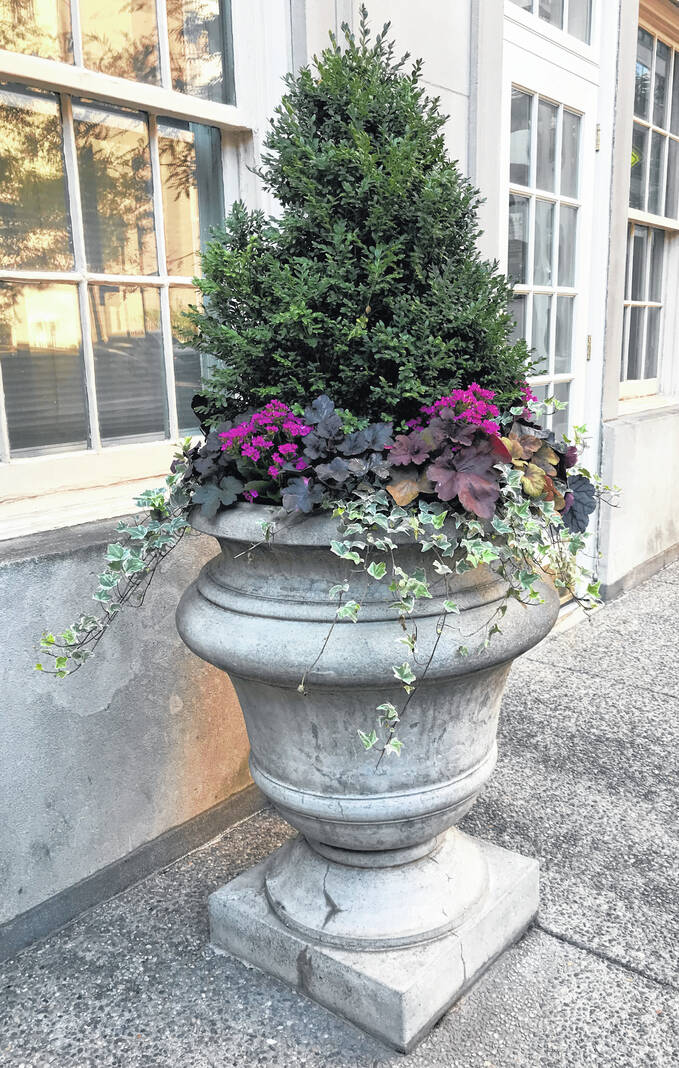
This handsome planter, on Philadelphia’s Rittenhouse Square, features a boxwood shrub surrounded by perennial coral bells, variegated ivy and tropical kalanchoe.
GoodSeed Farm photo
Container gardening is a popular way to enjoy summer color. Whether you grow houseplants indoors, vegetables or annual flowers in pots or window boxes outdoors, there is an endless variety of effects you can enjoy.
There are many reasons to grow in containers rather than in traditional garden beds. Above-ground containers are easier to plant, maintain and keep free of weeds. You can move fragile plants indoors in cold weather, or out of the hot sun in the dog days of summer. It’s easy to change out container plants, so you can enjoy colorful cold-hardy pansies in spring and fall, and summer-loving flowers in the warmer months.
A huge benefit of container gardening is the control you have over soil and drainage. Commercial growers and “green thumbs” know that different plants like different soils, and that it’s easier to control soil moisture in containers because excess water can drain out by gravity. Plants breathe through their roots, so good growers prefer “fluffy” soilless mixes (bagged potting soil) over garden dirt.
Planter pots can be placed on your patio or deck, under trees where root competition would strangle your plants, or even on city sidewalks like the one in the photo. They can be easily rearranged for best effect. So, if we agree that you can’t have too many planter pots, what plants work best for container growing?
Summer annuals, herbs and vegetables are the most common container plants. So are tropical houseplants and trees like Hibiscus and gardenia. All of these plants grow well in containers and have long been popular. Most people don’t think of growing perennials in planter pots, but there are many that would thrive there. Succulents like sedum, hens & chicks and cactus tolerate dryness, so they are obvious choices. Ferns need more attention, but they are popular container plants and dress up any porch in an attractive pot.
Less common are woody plants like boxwood, but these evergreens can live year-round in containers so they can be permanent architectural features, framing doorways and gates. Adding some ivy around the bottom, and perhaps a colorful foliage perennial like purple coral bells, can really dress up an evergreen planter.
When considering any plant for a year-round container, pay close attention to the hardiness zone. Hardiness is a function of soil (root system) temperature. Since container soil gets much colder than the ground under it, you should pick Zone 4 (or lower) hardiness even though the Ohio Valley is Zone 6.
You also need to choose your container soil carefully, and make sure there is sustained-release fertilizer mixed into it. We like Espoma Plant Tone or Holly Tone for this purpose, because it includes vital soil microbes that most potting soils lack.
Most people leave the container soil for much too long; we believe it should be replaced every year or two. Turning out the container soil and plants, and re-planting in fresh soil, is the key to healthy containers over time. In the meantime, sustained release plant foods like Osmocote can be sprinkled on top. Container-grown plants need watering more frequently as well, since excess water simply drains out the bottom.
We have dozens of planter pots in various sizes on our porch, patio and scattered throughout our gardens. This ever-changing display adds a whole new dimension to our landscaping, and makes our outdoor living spaces a tropical paradise.
Steve Boehme is a landscape designer/installer specializing in landscape “makeovers”. “Let’s Grow” is published weekly; column archives are on the “Garden Advice” page at www.goodseedfarm.com. For more information is available at www.goodseedfarm.com or call GoodSeed Farm Landscapes at (937) 587-7021.




